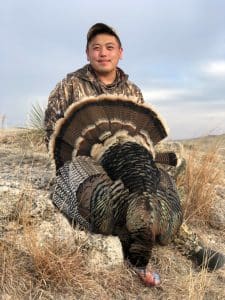Scouting for Turkeys
Late winter is a great time to start scouting for turkeys. During this time, you can find them hanging out in big groups, making them easier to spot while glassing. Turkeys tend to hang out in three primary types of groups: Toms (mature males), Jakes (young males), and Hens (females). You will also find them intermingling at different times.
Start by driving around public land or near private land that is close to public land areas. Most birds, including turkeys are pretty easy to pattern. From the time they leave the roost, to the areas they visit during the day, you can almost always count on the same bird or group of birds doing the same thing each day.
Observation
When you have found them on your scouting trip, park your car and watch them. The longer you watch, the better. There are a couple things you will want to note. The time you spotted them, and what type of turkey they are will be the first couple items to note. Next you want to note how many you see and what are they doing (eating, foraging, resting, interacting with each other). Also you will want to observe what kind of sounds are they making and what are the responses (physically, and vocally) that are being returned. The more groups you find and the larger the groups are, the better. This will improve your chances of harvesting a bird in the spring.
Practice Calling
This is also a great time to pull out the turkey call and make mistakes. See what kind of responses you get from the Turkeys. Can you get them to approach closer to you? What noises made them run away? Practice your mistakes now so that you make fewer mistakes during the hunt.
Remember that as a new hunter, you must study these birds religiously. Yes, you can get lucky and shoot one on your first try. However, to improve your odds, plan on finding and watching them for a couple hours. Make sure to take note of their patterns and habits before the season begins. As the daylight lengthens and the spring strutters preen their feathers for the main show, so does their behavior. The groups break up, Toms gobble at first light, and they become less transient as hens either stick around areas of good nesting habitat, or will travel miles to find new habitat to nest.
To learn more about hunting Turkeys such as figuring out what kind of signs and habitat to look for during the hunt, sign up for the How to Hunt Turkeys course on Hunting Camp Live.
This post is by Keng Yang from Minnesota Hunter.
Register for Online Class – How To Hunt Turkeys
More Turkey “How-To” Articles on Modern Carnivore:



Share this: